Salvador Dali

 Salvador Dali, one of the greatest Spanish
painters of all time, and one of the most important figures in the
history of Modernism. Both Dali's extraordinary
talent and odd personality helped him to rise above the rest of the
Surrealists of the 20th century. His artwork and influences can be
seen almost everywhere around the world. His explicit and
controversial Surrealist paintings are some of the most famous, and
infamous, paintings of the 1900's, and his rebellious and independent
attitude towards art and politics set him aside from other painters,
leaving a mark on Surrealist painting forever. Dali expressed
surrealism in everything he said and did. He was not just
unconventional and dramatic; he was fantastic, shocking, and
outrageous. Salvador Dali remains one of the great artistic innovators
of all time. Like Picasso,
Matisse, Miro and
Chagall, his place at the pinnacle of modern
art history is assured.
Salvador Dali, one of the greatest Spanish
painters of all time, and one of the most important figures in the
history of Modernism. Both Dali's extraordinary
talent and odd personality helped him to rise above the rest of the
Surrealists of the 20th century. His artwork and influences can be
seen almost everywhere around the world. His explicit and
controversial Surrealist paintings are some of the most famous, and
infamous, paintings of the 1900's, and his rebellious and independent
attitude towards art and politics set him aside from other painters,
leaving a mark on Surrealist painting forever. Dali expressed
surrealism in everything he said and did. He was not just
unconventional and dramatic; he was fantastic, shocking, and
outrageous. Salvador Dali remains one of the great artistic innovators
of all time. Like Picasso,
Matisse, Miro and
Chagall, his place at the pinnacle of modern
art history is assured.
Surreal
Salvador Dali (1929 - 1941)
> analysis of art, paintings, and works...
- The Great Masturbator (1929)
- Illumined Pleasures (1929)
- The Invisible Man (1929)
- Portrait of Paul Eluard (1929)
- Invisible Sleeping Woman (1930)
- The Dream (1931)
- Le Spectre et le Fantome (1931)
- The Persistence of Memory (1931)
- Shades of Night Descending (1931)
- Gradiva Finds the Anthropomorphic Ruins (1931)
- They Were There (1931)
- Eggs on the Plate Without the Plate (1932)
- Angelus (1932)
- The Dream Approaches (1933)
- The Architectural Angelus of Millet (1933)
- Gala and the Angelus of Millet Preceding the Imminent Arrival of the Conical Anamorphoses (1933)
- Necrophilic Fountain Flowing from a Grand Piano (1933)
- The Triangular Hour (1933)
- Enigmatic Elements in the Landscape (1934)
- Masochistic Instrument (1934)
- Moment of Transition (1934)
- The Weaning of Furniture-Nutrition (1934)
- The Angelus of Gala (1935)
- Archaeological Reminiscence of Millet's Angelus (1935)
- Paranoiac-Critical Solitude (1935)
- The Horseman of Death (1935)
- The Anthropomorphic Cabinet (1936)
- Autumn Cannibalism (1936)
- Sun Table (1936)
- The Burning Giraffe (1937)
- The Invention of the Monsters (1937)
- Metamorphosis of Narcissus (1937)
- Sleep (1937)
- Swans Reflecting Elephants (1937)
- The Endless Enigma (1938)
- Impressions of Africa (1938)
- Spain (1938)
- The Enigma of Hitler (1939)
- Philosopher Illuminated by the Light of the Moon and the Setting Sun (1939)
- Daddy Longlegs of the Evening... Hope! (1940)
- Old Age, Adolescence, Infancy (The Three Ages) (1940)
- Slave Market with the Disappearing Bust of Voltaire (1940)
- Two Pieces of Bread, Expressing the Sentiment of Love (1940)
The Great Masturbator (1929)
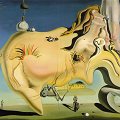 Get
Get  a high-quality picture of
The Great Masturbator for your computer or notebook. ‣
The Great Masturbator is a self-portrait painted in July
1929. Dali's head has the shape of a rock formation near his home and
is seen in this form in several paintings dating from 1929. The
painting deals with Dali's fear and loathing of sex. He blamed his
negative feelings toward sex as partly a result of reading his
father's, extremely graphic book on venereal diseases as a young
boy.
a high-quality picture of
The Great Masturbator for your computer or notebook. ‣
The Great Masturbator is a self-portrait painted in July
1929. Dali's head has the shape of a rock formation near his home and
is seen in this form in several paintings dating from 1929. The
painting deals with Dali's fear and loathing of sex. He blamed his
negative feelings toward sex as partly a result of reading his
father's, extremely graphic book on venereal diseases as a young
boy.
The head is painted "soft", as if malleable to the touch; it looks fatigued, sexually spent: the eyes are closed, the cheeks flushed. Under the nose a grasshopper clings, its abdomen covered with ants that crawl onto the face where a mouth should be. From early childhood, Dali had a phobia of grasshoppers and the appearance of one here suggests his feelings of hysterical fear and a loss of voice or control.
Emerging from the right of the head, a woman moves her mouth toward a man's crotch. The man's legs are cut and bleeding, implying a fear of castration. The woman's face is cracked, as though the image that Dali's head produces will soon disintegrate. To reiterate the sexual theme, the stamen of a lily and tongue of a lion appear underneath the couple.
Illumined Pleasures (1929)
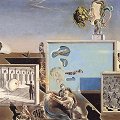 Get
Get  a high-quality picture of
Illumined Pleasures for your computer or notebook. ‣
Illumined Pleasures was created by fusing oil and collage
on panel. The canvas of the painting is small, measuring only 10" x
14" (24 x 34.5 cm); its size compared with the mass of detail Dali has
managed to cram into it, clearly reveals Dali's great talent as a
miniaturist painter.
a high-quality picture of
Illumined Pleasures for your computer or notebook. ‣
Illumined Pleasures was created by fusing oil and collage
on panel. The canvas of the painting is small, measuring only 10" x
14" (24 x 34.5 cm); its size compared with the mass of detail Dali has
managed to cram into it, clearly reveals Dali's great talent as a
miniaturist painter.
Other Surrealist artists, in both paintings and objects, had made use of boxes. Here Dali uses them to create scenarios - pictures within the main picture. In the middle box is a self-portrait, like that of The Great Masturbator. Blood flows out of the nose and above the head is a grasshopper: both symbolise an hysterical fear. The box to the left shows a man shooting at a rock. This rock can be construed as a head, with blood flowing from the holes. The box to the right has a pattern of men on cycles with sugared almonds placed on their heads.
The painting has a chaotic, frenzied energy; it is filled with violent images. In the foreground, a couple is struggling. The woman's hands are covered in blood as she grasps at a swirl of a blue that emanates from the self-portrait, as if trying to catch the essence of Dali.
The Invisible Man (1929)
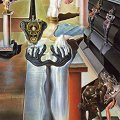 Get
Get  a high-quality picture of
The Invisible Man for your computer or notebook. ‣
Though begun in 1929, The Invisible Man was not completed
until 1932. It was the first painting in which Dali began to use the
double images that were to flood his work over the next decade,
during his "paranoia-critical" period. The double images used here are
not as successful as the later painting, Swans Reflecting
Elephants (1937). The viewer is aware of the illusions that Dali
is creating before they are aware of what the overall form is meant
to be.
a high-quality picture of
The Invisible Man for your computer or notebook. ‣
Though begun in 1929, The Invisible Man was not completed
until 1932. It was the first painting in which Dali began to use the
double images that were to flood his work over the next decade,
during his "paranoia-critical" period. The double images used here are
not as successful as the later painting, Swans Reflecting
Elephants (1937). The viewer is aware of the illusions that Dali
is creating before they are aware of what the overall form is meant
to be.
The yellow clouds become the man's hair; his lace and upper torso are formed by ruined architecture that is scattered in the landscape and a waterfall creates the vague outline of his legs. As with almost all Dali's work in 1929, this painting deals with his fear of sex. The recurring image of the "jug woman" appears on the left of the picture. To the right of her is an object with a womb shape, part of which delineates the right arm of the man. The dark shape outlining the fingers and legs of the man suggests the female form. Beneath the man a wild beast is prowling - another of Dali's recurring sexual symbols.
Portrait of Paul Eluard (1929)
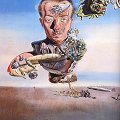 Get
Get  a high-quality picture of
Portrait of Paul Eluard for your computer or notebook. ‣
This portrait dates from the same year as The Great
Masturbator and shares the same themes of sexual frustration and
fear. Although it is a portrait, the painting tells us more of Dali's
emotional state at this time than that of the subject, Paul Eluard,
who was a French poet of the Surrealist movement. Together with his
wife Gala, Eluard visited Dali at Cadaques during the summer of 1929.
Dali and Gala fell in love, beginning their fifty-year
relationship.
a high-quality picture of
Portrait of Paul Eluard for your computer or notebook. ‣
This portrait dates from the same year as The Great
Masturbator and shares the same themes of sexual frustration and
fear. Although it is a portrait, the painting tells us more of Dali's
emotional state at this time than that of the subject, Paul Eluard,
who was a French poet of the Surrealist movement. Together with his
wife Gala, Eluard visited Dali at Cadaques during the summer of 1929.
Dali and Gala fell in love, beginning their fifty-year
relationship.
The bust of Eluard hovers over a bleak landscape. From the right of his head a lion appears. This features heavily in Dali's work during 1929-1930 - he defined the head as symbolic of his fear of sexual performance with a woman; he was a virgin when he met Gala. The lion's head often appears, as it does here, next to a woman's head which is shaped as a jug. Dali's Freudian interpretation of the lion leads us to see the jug/woman as a vessel that eagerly waits to be filled; she grins at the lion lasciviously. On the left, Dali has placed a self-portrait with a grasshopper across his face; to the artist the grasshopper represented hysterical fear and disgust.
Invisible Sleeping Woman (1930)
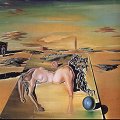 Get
Get  a high-quality picture of
Invisible Sleeping Woman for your computer or notebook. ‣
This analytical work is one of the first painted in the new house
in Port Lligat during the summer Of 1930. In his numerous written
works Dali has given us much information about this picture. "A month
after my return from Paris," he writes, "I signed a contract with
George Keller and Pierre Colle. Shortly after in the latter's gallery
I exhibited my Invisible Sleeping Woman, Horse, Lion, fruit of
my contemplation at Cape Creus." The Viscount of Noailles bought this
oil. Invisible Sleeping Woman, Horse, Lion must be considered
the most important painting after The Invisible Man among
Dali's early experiments with double images. The permanent theme
which predominates over all the others is that of the persistence of
desires.
a high-quality picture of
Invisible Sleeping Woman for your computer or notebook. ‣
This analytical work is one of the first painted in the new house
in Port Lligat during the summer Of 1930. In his numerous written
works Dali has given us much information about this picture. "A month
after my return from Paris," he writes, "I signed a contract with
George Keller and Pierre Colle. Shortly after in the latter's gallery
I exhibited my Invisible Sleeping Woman, Horse, Lion, fruit of
my contemplation at Cape Creus." The Viscount of Noailles bought this
oil. Invisible Sleeping Woman, Horse, Lion must be considered
the most important painting after The Invisible Man among
Dali's early experiments with double images. The permanent theme
which predominates over all the others is that of the persistence of
desires.
Speaking of this picture, Dali has given a definition: "The double image (the example of which may be that of the image of the horse alone which is at the same time the image of a woman) can be prolonged, continuing the paranoiac process, the existence of another obsessive idea being then sufficient to make a third image appear (the image of a lion, for example) and so forth, until the concurrence of a number of images, limited only by the degree of the capacity for paranoiac thought." The violently erotic character of the group of fellateurs metamorphosed into the forelegs and the head of the horse is veiled by the immutable aspect of the ensemble, obtained with the help of an absence of dense shadows and violent colors, as well as by the geological character of the forms. Dali said of these models: "They are always boats which seem to be drawn by exhausted fishermen, by fossil fishermen."
Dali painted three pictures of the same subject with different titles. One of the three was destroyed during the demonstrations which broke out when the film L'Age dor was being shown at Studio 28 in Paris on December 3, 1930.
The Dream (1931)
 Get
Get  a high-quality picture of
The Dream for your computer or notebook. ‣
By the Thirties, Surrealist painting had moved toward the arena of
dreams for inspiration and relied less on the ideas of automatism
that had marked the beginning of the movement. The Dream was
painted in 1931 but the main image, the woman's head, had first
appeared the year before in The Fountain, where, although in
the background, it was a striking and dominant feature. Dali found
the inspiration for the woman from a scene on a box and a monument in
Barcelona.
a high-quality picture of
The Dream for your computer or notebook. ‣
By the Thirties, Surrealist painting had moved toward the arena of
dreams for inspiration and relied less on the ideas of automatism
that had marked the beginning of the movement. The Dream was
painted in 1931 but the main image, the woman's head, had first
appeared the year before in The Fountain, where, although in
the background, it was a striking and dominant feature. Dali found
the inspiration for the woman from a scene on a box and a monument in
Barcelona.
In the foreground of this dark painting is the bust of a woman, painted in dull, metallic grays, her hair floating above her as if frozen in movement. The colors used and her apparent immobility bring to mind the Classical myth of Medusa. The woman has no mouth and her eyes also appear sealed shut, like those of the giant head in Sleep. The absence of a mouth, together with the seeming immobility of the woman implies a loss of control, of paralysis. Ants crawl across the face in the place where a mouth should be. As a child, Dali had found a pet bat crawling with ants and so, for him, they became symbols of death and decay.
Le Spectre et le Fantome (1931)
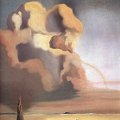 Get
Get  a high-quality picture of
Le Spectre et le Fantome for your computer or notebook. ‣
Le Spectre et le Fantome - the spectre and the phantom - is
one of a series of paintings that shared a theme of spectral and
phantom appearances. In a letter to the French Surrealist poet Paul
Eluard, Dali defined the clouds and the rainbow as being the spectre
and the brick shape as being the phantom. The clouds take on forms as
the viewer stares at them, reflecting the basis of Dali's
paranoia-critical method.
a high-quality picture of
Le Spectre et le Fantome for your computer or notebook. ‣
Le Spectre et le Fantome - the spectre and the phantom - is
one of a series of paintings that shared a theme of spectral and
phantom appearances. In a letter to the French Surrealist poet Paul
Eluard, Dali defined the clouds and the rainbow as being the spectre
and the brick shape as being the phantom. The clouds take on forms as
the viewer stares at them, reflecting the basis of Dali's
paranoia-critical method.
The work has the same female figure as Mediumistic-Paranoaic Image. The woman is in the foreground, sitting in a puddle on a beach. She is a combination of Dali's nurse, his friend Lidia and another of Dali's obsessions from that time which was to cause him trouble in the future: Hitler. His obsession with Hitler was partly caused by what he called the "soft flesh" of his back, which was tightly held in by his uniform. He dreamt of him as a wet nurse sitting knitting in a puddle. The woman in the painting has a small cut taken out of her back that emphasizes this obsession with "Hitlerian" flesh.
The Persistence of Memory (1931)
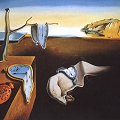 Get
Get  a high-quality picture of
The Persistence of Memory for your computer or notebook. ‣
Many of Dali's paintings were influenced and inspired by the
landscapes of his youth. Several in particular were painted on the
slopes of Mount Pani, which was covered in beautiful umbrella pines
at the time. Many of the strange and foreboding shadows in the
foreground of many Dali paintings is a direct reference to and result
of Dali's love of this mountain near his home. Even long after he had
grown up, Dali continued to paint details of the landscape of
Catalonia into his works, as evidenced by such works as The
Persistence of Memory, completed in 1931.
a high-quality picture of
The Persistence of Memory for your computer or notebook. ‣
Many of Dali's paintings were influenced and inspired by the
landscapes of his youth. Several in particular were painted on the
slopes of Mount Pani, which was covered in beautiful umbrella pines
at the time. Many of the strange and foreboding shadows in the
foreground of many Dali paintings is a direct reference to and result
of Dali's love of this mountain near his home. Even long after he had
grown up, Dali continued to paint details of the landscape of
Catalonia into his works, as evidenced by such works as The
Persistence of Memory, completed in 1931.
Note the craggy rocks of Cape Creus in the background to the right. One of Dali's most memorable Surrealist works, indeed the one with which he is most often associated is The Persistence of Memory. It shows a typical Dalinian landscape, with the rocks of his beloved Cape Creus jutting up in the background. In the foreground, a sort of amorphous self portrait of Dali seems to melt. Three Separate Melting Watch images even out the foreground of the work. The melting watches are one symbol that is commonly associated with Salvador Dali's Surrealism. They are literally meant to show the irrelevance of time.
When Dali was alone with Gala and his paintings in Cape Creus, he felt that time had little, perhaps no significance for him. His days were spent eating, painting, making love, and anything else he wanted to do. The warm, summery days seemed to fly by without any real indication of having passed.
One hot August afternoon, in 1931, as Dali sat at his work bench nibbling at his lunch, he came upon one of his most stunning paranoiac-critical hallucinations. Upon taking a pencil, and sliding it under a bit of Camembert cheese, which had become softer and runnier than usual in the summer heat, Dali was inspired with the idea for the melting watches. They appear often throughout Dali's works, and are the subject of much interest. In short, this particular work, is an important referral back to Dali's Catalan Heritage, that was so very important to him.
Shades of Night Descending (1931)
 Get
Get  a high-quality picture of
Shades of Night Descending for your computer or notebook. ‣
The obsessive character of this work is made evident by one of the
less important elements and the least noticed by the viewer: the
measureless shadow which is spread out in the bottom part of the
canvas. Its obsessional power is obtained by having in the center a
rock whose shadow is much less dense that that of the one in the
foreground. In appearance this reef seems to be a rock like the
others; however, it is already constructed in such a way that its
shadow bears a resemblance, due to its design, to the one in the
foreground. Their source is moreover quite different, and it is there
that the painter has successfully applied his famous
paranoiac-critical method.
a high-quality picture of
Shades of Night Descending for your computer or notebook. ‣
The obsessive character of this work is made evident by one of the
less important elements and the least noticed by the viewer: the
measureless shadow which is spread out in the bottom part of the
canvas. Its obsessional power is obtained by having in the center a
rock whose shadow is much less dense that that of the one in the
foreground. In appearance this reef seems to be a rock like the
others; however, it is already constructed in such a way that its
shadow bears a resemblance, due to its design, to the one in the
foreground. Their source is moreover quite different, and it is there
that the painter has successfully applied his famous
paranoiac-critical method.
The shadow in the foreground is that of a concert grand piano, an instrument which holds a predominant place in many of Dali's Surrealist compositions, such as Diurnal Illusion: the Shadow of a Grand Piano Approaching, 1931; Average Bureaucrat; Six apparitions of Lenin on a Grand Piano, 1931; or Myself at the Age of Ten When I Was a Grasshopper Child, 1933. This piano is "the one that belonged to the Pichots with its shadows," Dali relates; "I was impressed by these shadows in the setting sun, near the tall cypress in the interior court of the house, and another time when they had brought the instrument onto the rocks beside the water." The spectral victory standing in the lower-right corner of the picture is concealing heteroclite objects, half-hidden under the drapery in whose tortured folds the figure is wrapped. Two of these things, a glass and a shoe, are used with the same impact to stretch out the skin on the back of the figure in Diurnal Illusion. Speaking of his fetishism, Dali has said, "It was a question of all the fetishes and slippers of my childhood fossilized underneath the membranes of my anguish, all mimetized at Cap Creus." Shoe fetishes appear often in scenes of "bureaucratic cannibalism," where one can see the most varied figures: a girl, Nietzche, or Maxim Gorky devouring a high-heeled shoe.
Gradiva Finds the Anthropomorphic Ruins (1931)
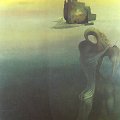 Get
Get  a high-quality picture of
Gradiva Finds the Anthropomorphic Ruins for your computer or notebook. ‣
Gradiva Finds the Ruins of Anthropomorphis was based on a
German story, analyzed by Freud, of an archeologist who falls in love
with Gradiva, a girl he sees in a Greek stone relief. He later finds
his true love, who is the reincarnation of Gradiva. The Surrealists
took this myth for their own. For them, Gradiva meant "she who
advances", a woman who would lead to self-discovery. To Dali, Gradiva
was Gala, the realization of his fictional past loves and his muse.
a high-quality picture of
Gradiva Finds the Anthropomorphic Ruins for your computer or notebook. ‣
Gradiva Finds the Ruins of Anthropomorphis was based on a
German story, analyzed by Freud, of an archeologist who falls in love
with Gradiva, a girl he sees in a Greek stone relief. He later finds
his true love, who is the reincarnation of Gradiva. The Surrealists
took this myth for their own. For them, Gradiva meant "she who
advances", a woman who would lead to self-discovery. To Dali, Gradiva
was Gala, the realization of his fictional past loves and his muse.
In Gradiva Finds the Ruins, Dali plays with the story of Gradiva. Set against a flat, dark landscape, she is in the foreground with her arms wrapped around a human shape that is made from stone, (Anthropomorphis). Parts of the figure are cracked and there are holes where the face, heart and genitals should be, implying that this creature is without any of the parts that constitute a human. The form of Anthropomorphis is similar to that of a figure, which can be interpreted as Dali, in the painting Solitude (1931). The figure has a Dalinian inkwell on his shoulder and as Gradiva appears as Gala, the implication here is that Dali is Anthropomorphis.
They Were There (1931)
 Get
Get  a high-quality picture of
They Were There for your computer or notebook. ‣
Dali had many different ways of signing a painting; sometimes
using an emblem or a crown. They Were There is signed "Gala
Dali"; he had begun signing his work with both his and Galas names in
1931. Dali said that this was because it was mostly with Gala's blood
that he painted. The signature on this painting was made with
blood-red paint to emphasize this point.
a high-quality picture of
They Were There for your computer or notebook. ‣
Dali had many different ways of signing a painting; sometimes
using an emblem or a crown. They Were There is signed "Gala
Dali"; he had begun signing his work with both his and Galas names in
1931. Dali said that this was because it was mostly with Gala's blood
that he painted. The signature on this painting was made with
blood-red paint to emphasize this point.
They Were There is a portrait, though the subject is unknown. The man stands in the foreground staring straight out at the viewer, which was unusual for Dali's portraits. He appears relaxed with one hand in the pocket of his casual suit, a cigarette in the other hand. The background of the painting is the usual desert, bounded by green hills. The man on the rearing horse is an image also seen in Mme. Reese. They Were There does not show Dali's usual eye for the miniature details, the trees in the background are basic and little effort seems to have been taken over the clouds either. In both Mme. Reese and They Were There the brushwork on the people is very smooth; there are no wrinkles or lines, giving an almost plastic quality.
Eggs on the Plate Without the Plate (1932)
 Get
Get  a high-quality picture of
Eggs on the Plate Without the Plate for your computer or notebook. ‣
Dali tells us that this work was inspired by an intra-uterine
memory. He says that one day, after vigorously rubbing his eyes, he
became fascinated with the brilliant yellow, orange, and ochre colors
he saw. As a result, he says, he had a flashback to his mother's
womb, and created this paranoiac-critical explanation of the
experience.
a high-quality picture of
Eggs on the Plate Without the Plate for your computer or notebook. ‣
Dali tells us that this work was inspired by an intra-uterine
memory. He says that one day, after vigorously rubbing his eyes, he
became fascinated with the brilliant yellow, orange, and ochre colors
he saw. As a result, he says, he had a flashback to his mother's
womb, and created this paranoiac-critical explanation of the
experience.
Suspended on a string, in the center of the work is a single egg yolk, which Dali said represented himself in the womb. Below that, the two eggs on the plate (curious, that plate, look at the title again) were painted with a shimmering yolk. These represented the piercing gaze of Gala Dali, whom Dali had met in 1929. At the time, she had been the darling of the Surrealist movement, not to mention the wife of Paul Eluard, the French poet. It was said that her gaze could pierce through walls, and Dali is paying her homage here.
A large, cubist building dominates the scene, while other objects are attached to the wall facing the eggs. First is a small, dripping watch, a continuation of the theme of the melting watches done in The Persistence of Memory. Above that is a phallic ear of corn, representing male sexuality. Just to the left of the ear of corn is a window in the building, and standing in it, looking out through another window, are the father and son figures that were originally painted in The First Days of Spring, some three years ago. Off in the distance are the rocks of Dali's homeland.
Angelus (1932)
 Get
Get  a high-quality picture of
Angelus for your computer or notebook. ‣
The True Picture of the "Island of the Dead" by Arnold Bocklin
at the Hour of the Angelus is Dali's reworking of the German
painter Arnold Bocklin's piece, Island of the Dead; Dali was
writing a study on Bocklin during this period. Bocklin said that the
Island of the Dead was a painting "to dream over",
deliberately leaving it untitled so that the meaning remained open to
interpretation by the viewer. Bocklin's thoughts were very close to
views held by the Surrealists, especially Dali. On the left appear
the only objects: a cup with a thin rod attached to it sitting on a
block. Using Freudian dream interpretation (which is evident
throughout Dali's early work) any receptacle is female and any rod is
regarded as phallic. Read as male and female, these objects could be
the reason for Dali's inclusion of the "Angelus" in the title.
a high-quality picture of
Angelus for your computer or notebook. ‣
The True Picture of the "Island of the Dead" by Arnold Bocklin
at the Hour of the Angelus is Dali's reworking of the German
painter Arnold Bocklin's piece, Island of the Dead; Dali was
writing a study on Bocklin during this period. Bocklin said that the
Island of the Dead was a painting "to dream over",
deliberately leaving it untitled so that the meaning remained open to
interpretation by the viewer. Bocklin's thoughts were very close to
views held by the Surrealists, especially Dali. On the left appear
the only objects: a cup with a thin rod attached to it sitting on a
block. Using Freudian dream interpretation (which is evident
throughout Dali's early work) any receptacle is female and any rod is
regarded as phallic. Read as male and female, these objects could be
the reason for Dali's inclusion of the "Angelus" in the title.
The island does not resemble the island in the Bocklin painting; it resembles more the shape of the head in Paranoiac Face, painted around the same time. It is probable that both of these paintings were based upon the same rocky, coastal scenery.
The Dream Approaches (1933)
 Get
Get  a high-quality picture of
The Dream Approaches for your computer or notebook. ‣
The Dream Approaches has the haunting atmosphere of a
dream, aided by a luminescent pre-dawn sky. In the foreground of the
painting is a potentially coffin-shaped form, over which white
material is draped. On the right side of this block is a large cocoon
shape, its opening suggesting the female genitalia. Standing on the
sandy beach is a naked man, Classical in form as well as stance, with
one hand raised and his hips tilted. The brushwork on his body
creates the illusion that dark flames are swirling along his back.
a high-quality picture of
The Dream Approaches for your computer or notebook. ‣
The Dream Approaches has the haunting atmosphere of a
dream, aided by a luminescent pre-dawn sky. In the foreground of the
painting is a potentially coffin-shaped form, over which white
material is draped. On the right side of this block is a large cocoon
shape, its opening suggesting the female genitalia. Standing on the
sandy beach is a naked man, Classical in form as well as stance, with
one hand raised and his hips tilted. The brushwork on his body
creates the illusion that dark flames are swirling along his back.
On the right, next to two trees that are still half in darkness, is a tall tower with one solitary window at the top. The tower seems like a ruin as the plaster is falling away and there are cracks along it. Amongst other paintings, this tower can also be seen in The Horseman of Death (1934). Towers appear in Dali's work as a symbol of desire and death. In his autobiographical writings, Dali explained this as owing to his childhood memories of a mill tower, where he had felt both sexual and violent urges toward a girl.
The Architectural Angelus of Millet (1933)
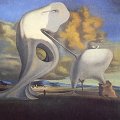 Get
Get  a high-quality picture of
The Architectural Angelus of Millet for your computer or notebook. ‣
The Architectonic Angelus of Millet shows how Dali used the
"paranoia-critical" method, employing Millet's The Angelus as
the catalyst. Dali saw a reproduction of The Angelus in 1929,
not having thought about it since childhood. He had been obsessed
with the image as a child, finding parallels between that and two
cypress trees that stood outside his classroom. Upon seeing this
reproduction, he became very upset and distressed; to discover why he
employed psychoanalytical methods. He also began to see The
Angelus in "visions" in objects around him: once in a lithograph
of cherries, once in two stones on a beach. The Architectonic
Angelus of Millet was based upon this latter "vision".
a high-quality picture of
The Architectural Angelus of Millet for your computer or notebook. ‣
The Architectonic Angelus of Millet shows how Dali used the
"paranoia-critical" method, employing Millet's The Angelus as
the catalyst. Dali saw a reproduction of The Angelus in 1929,
not having thought about it since childhood. He had been obsessed
with the image as a child, finding parallels between that and two
cypress trees that stood outside his classroom. Upon seeing this
reproduction, he became very upset and distressed; to discover why he
employed psychoanalytical methods. He also began to see The
Angelus in "visions" in objects around him: once in a lithograph
of cherries, once in two stones on a beach. The Architectonic
Angelus of Millet was based upon this latter "vision".
Unlike Gala and The Angelus of Millet, The Architectonic Angelus has no reproduction of The Angelus. Instead, the Angelus couple are transformed into two huge, white stones that loom over the Catalonian landscape. Dali pointed out that although the male stone on the left appears to be dominant due to its size, the female stone is the aggressor here, pushing out a part of herself to make physical contact with the male. The often-used image of the young Dali with his father can be seen sheltering underneath the male stone.
Gala and the Angelus of Millet Preceding the Imminent Arrival of the Conical Anamorphoses (1933)
 Get
Get  a high-quality picture of
Gala and the Angelus of Millet Preceding the Imminent Arrival of the Conical Anamorphoses for your computer or notebook. ‣
In this interior scene reproduced here in nearly actual size, Dali
has brought together some of the characters or the obsessional themes
of his Surrealist works before 1935. In the background, Gala, smiling,
contemplates the scene; she is dressed in a richly embroidered jacket
and is wearing a white cap with a transparent yellow-green visor which
was then ih style. The seated figure facing her, one hand placed on
the table near a ball and a precariously balanced cube, is easily
recognizable: it is Lenin. On the left, the indiscrete mustachioed man
eavesdropping behind the door is Maxim Gorky; on his head there is a
lobster, a crustacean that the painter often places in equally
anachronistic spots, even creating in 1936 an object known as the
"lobster-telephone." Along with the soft watches, one of the most
persistent obsessive images in Dali's works is undoubtedly The
Angelus of Jean-Francois Millet, painter of the peasant world.
a high-quality picture of
Gala and the Angelus of Millet Preceding the Imminent Arrival of the Conical Anamorphoses for your computer or notebook. ‣
In this interior scene reproduced here in nearly actual size, Dali
has brought together some of the characters or the obsessional themes
of his Surrealist works before 1935. In the background, Gala, smiling,
contemplates the scene; she is dressed in a richly embroidered jacket
and is wearing a white cap with a transparent yellow-green visor which
was then ih style. The seated figure facing her, one hand placed on
the table near a ball and a precariously balanced cube, is easily
recognizable: it is Lenin. On the left, the indiscrete mustachioed man
eavesdropping behind the door is Maxim Gorky; on his head there is a
lobster, a crustacean that the painter often places in equally
anachronistic spots, even creating in 1936 an object known as the
"lobster-telephone." Along with the soft watches, one of the most
persistent obsessive images in Dali's works is undoubtedly The
Angelus of Jean-Francois Millet, painter of the peasant world.
This picture, which is in the Louvre in Paris, is reproduced in Dali's painting hung over the door. Dali attributes to this image an erotic significance explained in his book, Le Mythe tragique de L'Angelus de Millet, in which he describes in minute detail and at great length this delirious phenomenon. "In June 1932, there suddenly came to my mind without any close or conscious association, which would have provided an immediate explanation, the image of The Angelus of Millet. This image consisted of a visual representation which was very clear and in colors. It was nearly instantaneous and was not followed by other images. It made a very great impression on me, and was most upsetting to me because, although in my vision of the afore-mentioned image everything corresponded exactly to the reproductions of the picture with which I was familiar, it appeared to me nevertheless absolutely modified and charged with such latent intentionality that The Angelus of Millet Suddenly' became for me the pictorial work which was the most troubling, the most enigmatic, the most dense and the richest in unconscious thoughts that I had ever seen."
Necrophilic Fountain Flowing from a Grand Piano (1933)
 Get
Get  a high-quality picture of
Necrophilic Fountain Flowing from a Grand Piano for your computer or notebook. ‣
Necrophilic Spring Flowing from a Grand Piano shows one of
the many appearances that grand pianos make in Dali's work during the
Thirties. Dali explained their Surrealistic appearance on the beaches
or plains in his paintings, as a sight he had seen in reality: the
Pitchot family, who were close friends of the Dalis, performed
outdoor concerts, sometimes going to the extent of bringing a grand
piano with them.
a high-quality picture of
Necrophilic Fountain Flowing from a Grand Piano for your computer or notebook. ‣
Necrophilic Spring Flowing from a Grand Piano shows one of
the many appearances that grand pianos make in Dali's work during the
Thirties. Dali explained their Surrealistic appearance on the beaches
or plains in his paintings, as a sight he had seen in reality: the
Pitchot family, who were close friends of the Dalis, performed
outdoor concerts, sometimes going to the extent of bringing a grand
piano with them.
The piano has a puddle-shaped hole in the middle of its back, out of which a cypress tree grows. Cypress trees often appear in Dali's paintings of the Thirties, for example in The Dream Approaches (1932). These trees reminded Dali of the Pitchot estate, where he would spend long, happy hours in erotic daydreams.
The word "necrophilic" in the title recalls Dali's neurotic fears that penetrative sex would lead to his death. The hole in the piano seems reflective as if filled with water; it is the origin of the "necrophilic spring". From the middle of the piano underneath the keys, the spring flows into a piano-shaped hole in the ground. This hole insinuates a grave and death, so that the spring has become a necrophiliac.
The Triangular Hour (1933)
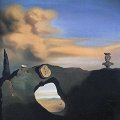 Get
Get  a high-quality picture of
The Triangular Hour for your computer or notebook. ‣
The Triangular Hour was painted using oil on canvas. After
their first appearance in The Persistence of Memory (1933),
Dali's "soft watches" were to become a regular image throughout his
work.
a high-quality picture of
The Triangular Hour for your computer or notebook. ‣
The Triangular Hour was painted using oil on canvas. After
their first appearance in The Persistence of Memory (1933),
Dali's "soft watches" were to become a regular image throughout his
work.
The watch in The Triangular Hour differs from other "soft watches" in that it has no metal casing. In addition it appears to be actually made from stone; it has a crack across its face that is similar to the cracks in the rock that it is placed on. It also does not appear as melted, as "soft", as other watches seen in earlier paintings; here it is merely misshapen.
The watch is mounted on a rock formation as if hung on a kitchen wall. Underneath is a hole in the rock through which we see an Ampordan plain, where the figure of a child with a hoop can be seen. At the top of the rock formation is the bust of a Classical man, his face in a grimace. Dali has placed rocks on top of the bust, as well as on top of the rock formation and on the other rock in the shadowy foreground. One interpretation of this painting is that Dali is viewing mankind and time as governed by the solidity of nature.
Enigmatic Elements in the Landscape (1934)
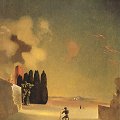 Get
Get  a high-quality picture of
Enigmatic Elements in the Landscape for your computer or notebook. ‣
This composition is entirely imaginary. It was painted in Paris in
1934 in the apartment that Dali and Gala occupied on the first floor
at 88 rue de l'Universite. The artist at work, pictured in the
foreground seated in front of his easel, is Vermeer of Delft
contemplating the wide plain of Ampurdan. Farther back one sees Dali
as a child in his sailor's suit holding his hoop and standing beside
his nurse of the type that he called Hitlerian nurses, much to the
great fury of the Surrealists; still farther back two soft forms are
coupled - they constitute part of that series of forms, erotic in
character, used by Dali during his Surrealist period which he called
"symbols" and of which he gave the following definition in the
Abridged Dictionary of Surrealism: "Morphological,
sub-cutaneous concretion, symbolic of hierarchies." At the lower
right two little fragments appear splashed with the morning light. A
silhouette, inexplicably and equivocally draped, rises up in front of
a row of cypress trees - those that Dali used to see through the
window in the courtyard of his school in Figueras; the lower is
reminiscent of the one on the Pichots' property, called the
Mill-Tower, near his birthplace; and behind this is a bell-tower
typical of Catalonian churches.
a high-quality picture of
Enigmatic Elements in the Landscape for your computer or notebook. ‣
This composition is entirely imaginary. It was painted in Paris in
1934 in the apartment that Dali and Gala occupied on the first floor
at 88 rue de l'Universite. The artist at work, pictured in the
foreground seated in front of his easel, is Vermeer of Delft
contemplating the wide plain of Ampurdan. Farther back one sees Dali
as a child in his sailor's suit holding his hoop and standing beside
his nurse of the type that he called Hitlerian nurses, much to the
great fury of the Surrealists; still farther back two soft forms are
coupled - they constitute part of that series of forms, erotic in
character, used by Dali during his Surrealist period which he called
"symbols" and of which he gave the following definition in the
Abridged Dictionary of Surrealism: "Morphological,
sub-cutaneous concretion, symbolic of hierarchies." At the lower
right two little fragments appear splashed with the morning light. A
silhouette, inexplicably and equivocally draped, rises up in front of
a row of cypress trees - those that Dali used to see through the
window in the courtyard of his school in Figueras; the lower is
reminiscent of the one on the Pichots' property, called the
Mill-Tower, near his birthplace; and behind this is a bell-tower
typical of Catalonian churches.
The owner, Mr. Cyrus Sulzberger, considers this picture a real good-luck charm. As a young man, he bought it while visiting the 32nd International Exhibition of Art at the Carnegie Institute in Pittsburgh in 1934, paying for it in installments of five dollars a week. Later he was forced to part with it. Only a few years ago (around 1991), he was able to convince its owner to sell him this painting, without which he could not get along.
Masochistic Instrument (1934)
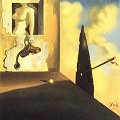 Get
Get  a high-quality picture of
Masochistic Instrument for your computer or notebook. ‣
The Masochistic Instrument interprets a childhood scene in
which Dali manipulated a female fruit-picker into climbing up a
ladder placed outside his room in order for her breasts and torso to
be framed by his window.
a high-quality picture of
Masochistic Instrument for your computer or notebook. ‣
The Masochistic Instrument interprets a childhood scene in
which Dali manipulated a female fruit-picker into climbing up a
ladder placed outside his room in order for her breasts and torso to
be framed by his window.
The viewer's eye is led to the naked woman by the insinuation of the angles that are created between the sloping roof beneath the window and the blue of the sky. The paleness of the woman's skin is highlighted by the use of shadow and by the contrasting, vividly colored walls of the house in which she stands. Her face can not be seen, lending an air of mystery to the piece. In her hand she holds a violin between two fingers as if in disgust. She looks ready to throw the fatigued violin away. It is "soft" and distorted like the cello seen in Daddy Longlegs of the Evening...Hope! (1940). The shape of the violin repeats the female form, but here the inference is that the violin should be read as a phallic object. The erect pole with a piece of cloth flowing from the end of it attached to the tree can also be read as phallic.
Moment of Transition (1934)
 Get
Get  a high-quality picture of
Moment of Transition for your computer or notebook. ‣
The Moment of Transition was painted in 1934. On the left,
a woman dressed entirely in white, the material flowing behind her,
stands facing the cart. The image of the woman in white is repeated
in several of Dali's paintings, either directly or suggestively. In
Gradiva Finds the Ruins of Anthropomorphis the woman's shape
is implied by the shape of the white rocks in the background. This
woman was Dali's first cousin, Carolinetta, who died aged seventeen
from consumption, when Dali was still a child.
a high-quality picture of
Moment of Transition for your computer or notebook. ‣
The Moment of Transition was painted in 1934. On the left,
a woman dressed entirely in white, the material flowing behind her,
stands facing the cart. The image of the woman in white is repeated
in several of Dali's paintings, either directly or suggestively. In
Gradiva Finds the Ruins of Anthropomorphis the woman's shape
is implied by the shape of the white rocks in the background. This
woman was Dali's first cousin, Carolinetta, who died aged seventeen
from consumption, when Dali was still a child.
The cart in the painting looks like a hollowed-out bone. On first glance the cart has two people in it, but upon closer inspection, the people take on the form of a building in the town it approaches and the rear end of a horse.
The Moment of Transition continues the theme of Dali's painting The Phantom Wagon (1933) in which the same cart, landscape, and visual illusion are shown. In the latter painting, however, the cart appears at a further distance from the town that it heads for. As we see the cart in closer detail in The Moment of Transition Dali's visual illusion becomes more apparent, explaining the title of the work.
The Weaning of Furniture-Nutrition (1934)
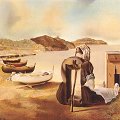 Get
Get  a high-quality picture of
The Weaning of Furniture-Nutrition for your computer or notebook. ‣
The center portion of this painting shows Dali's aging nurse Lucia
sitting with her back to us, in the position of a netmender.
Netmending was an important task in the Catalan fishing villages of
Dali's youth, and he associates that importance with Lucia. The hole
cut from her back is a paranoiac-critical transformation whose
original inspiration came from Dali's visit to Paris in 1928. There
he visited the Hotel of the Invalids, which sported windows made from
mannequins with holes cut into their mid-riffs. He transforms them
into the seated Lucia here, who is also shown being propped up by a
crutch, here a symbol of solemnity, a wish by Dali to support her as
she grows older.
a high-quality picture of
The Weaning of Furniture-Nutrition for your computer or notebook. ‣
The center portion of this painting shows Dali's aging nurse Lucia
sitting with her back to us, in the position of a netmender.
Netmending was an important task in the Catalan fishing villages of
Dali's youth, and he associates that importance with Lucia. The hole
cut from her back is a paranoiac-critical transformation whose
original inspiration came from Dali's visit to Paris in 1928. There
he visited the Hotel of the Invalids, which sported windows made from
mannequins with holes cut into their mid-riffs. He transforms them
into the seated Lucia here, who is also shown being propped up by a
crutch, here a symbol of solemnity, a wish by Dali to support her as
she grows older.
Next to Lucia, to her right, are a medicine table and bottle, supposedly the 'object' that has been removed from Lucia's back. Next to that is another smaller chest and bottle, these having been removed from the first.
To Lucia's left are 4 fishing boats which have been pulled up onto the shoreline. As is suggested by both Lucia's netmending, and the boats themselves, fishing was of paramount importance to the Catalonians on the coastline. Despite the craggy rocks and treacherous currents, fish had always been a staple in Dali's time. Farther off in the distance are a building and then the unique stepped hills of the Coasta Brava.
This work is actually very small in person, like many of the oil on panel paintings that Dali was doing at the time. It is reported that some of these were fashioned by Dali's use of a single horsehair for a brush, creating intricate levels of detail. When viewed in person, one can actually see the individual brush strokes in this work, which imparts a new sense of respect for Dali's still blooming talents.
The Angelus of Gala (1935)
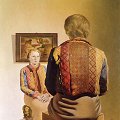 Get
Get  a high-quality picture of
The Angelus of Gala for your computer or notebook. ‣
Out of the series of paintings using the theme of Millet's The
Angelus, this painting portrays the emotional fears that the
painting aroused in Dali the most effectively. In The Secret Life
of Salvador Dali, Dali writes that he saw The Angelus,
which to most people is a religious work showing humble folk praying,
as a "monstrous example of disguised sexual repression".
a high-quality picture of
The Angelus of Gala for your computer or notebook. ‣
Out of the series of paintings using the theme of Millet's The
Angelus, this painting portrays the emotional fears that the
painting aroused in Dali the most effectively. In The Secret Life
of Salvador Dali, Dali writes that he saw The Angelus,
which to most people is a religious work showing humble folk praying,
as a "monstrous example of disguised sexual repression".
The Angelus of Gala contains two versions of The Angelus: the first is the unusual portrait of a double Gala, the second is the copy of The Angelus above Gala's head. The Gala that we see here is, unusually, unattractive; her mouth clenches tightly together, her eyes stare aggressively at her double. Looking at the reproduction of The Angelus above Gala, the female perches on the wheelbarrow, as does the main figure. The female in The Angelus is sexually aggressive; like a praying mantis, ready to devour her mate after receiving the attention that she hunts for. This explains the fierce look on Gala's face as she stares at her double, who is the male counterpart to her female "Angelus".
Archaeological Reminiscence of Millet's Angelus (1935)
 Get
Get  a high-quality picture of
Archaeological Reminiscence of Millet's Angelus for your computer or notebook. ‣
Millet's Angelus painting had a profound impact on Salvador Dali.
He had first seen the work as a child in school, but in 1932, he has
a series of experiences that led him to have several
paranoiac-critical transformations on the subject. The original
painting shows several peasants, working in a field, who have stopped
for an afternoon prayer. Their heads are bowed reverently, and there
is a wheelbarrow between them, with field scenery stretching out
behind them.
a high-quality picture of
Archaeological Reminiscence of Millet's Angelus for your computer or notebook. ‣
Millet's Angelus painting had a profound impact on Salvador Dali.
He had first seen the work as a child in school, but in 1932, he has
a series of experiences that led him to have several
paranoiac-critical transformations on the subject. The original
painting shows several peasants, working in a field, who have stopped
for an afternoon prayer. Their heads are bowed reverently, and there
is a wheelbarrow between them, with field scenery stretching out
behind them.
This painting is a continuation on that theme, but has several instances of Dalinian continuity included as well. The original two Angelus figures have been transformed into towering architectural ruins, which probably were inspired by Dali's visits to the Roman ruins near his childhood home. The third figure of the dead son is absent in this rendition of Dali's obsession with the original Millet painting. Instead, the female has been made to look even more like a praying mantis, thus reinforcing Dali's association of sex with death. Dali spent time on the plain of Ampurdan, and has added elements from that landscape into this one.
In the foreground, however, is another example of Dalinian continuity. Here we see yet again the tiny father/son figure that began to show up in Dali's works starting in 1929 with The First Days of Spring.
Paranoiac-Critical Solitude (1935)
 Get
Get  a high-quality picture of
Paranoiac-Critical Solitude for your computer or notebook. ‣
During 1935 and 1936, Dali's repetition and use of elements which
are completely out of place is remarkable. Here the desired effect is
obtained with the maximum of force, and the minimum of means. Dali
has taken a small piece of desolate landscape with some rocks. Into
his decor, he has placed an automobile, or rather a wreck of an
automobile - like those of Hibert-Robert - overgrown and half-covered
with flowering plants, and then has incorporated the machine into the
rocky crags, through which a hole has been pierced. Next, in a
paranoiac manner, he has divided the image in two by repeating it on
the left part of the rock while scrupulously re-creating the
silhouette of the vehicle, impressed in the hollow of the rock, of
which a piece, cut out in the same shape as the hole on the right,
appears suspended in front. The optical uneasiness of this picture
stems from the contradiction which exists between the piece of rock
on the left in relief and the empty space in the rock on the right,
which itself seems clearly in front of the car. Here in Dali's
research into dividing, one realizes how the stereoscopic phenomenon
has always interested him in a continuos way, because it is
definitely a question of the stereoscopic effect applied to the
problem of the dream in colors and relief. In this work, it is also
possible to understand the desire of the painter who is always
looking for examples in natural phenomena to explain certain
scientific laws, affirming that one day we will undoubtedly find in
geology traces of holograms, while today that possibility remains
quite out of the question in the minds of the specialists.
Paranoiac-Critical Solitude was painted on olive wood in Port
Lligat.
a high-quality picture of
Paranoiac-Critical Solitude for your computer or notebook. ‣
During 1935 and 1936, Dali's repetition and use of elements which
are completely out of place is remarkable. Here the desired effect is
obtained with the maximum of force, and the minimum of means. Dali
has taken a small piece of desolate landscape with some rocks. Into
his decor, he has placed an automobile, or rather a wreck of an
automobile - like those of Hibert-Robert - overgrown and half-covered
with flowering plants, and then has incorporated the machine into the
rocky crags, through which a hole has been pierced. Next, in a
paranoiac manner, he has divided the image in two by repeating it on
the left part of the rock while scrupulously re-creating the
silhouette of the vehicle, impressed in the hollow of the rock, of
which a piece, cut out in the same shape as the hole on the right,
appears suspended in front. The optical uneasiness of this picture
stems from the contradiction which exists between the piece of rock
on the left in relief and the empty space in the rock on the right,
which itself seems clearly in front of the car. Here in Dali's
research into dividing, one realizes how the stereoscopic phenomenon
has always interested him in a continuos way, because it is
definitely a question of the stereoscopic effect applied to the
problem of the dream in colors and relief. In this work, it is also
possible to understand the desire of the painter who is always
looking for examples in natural phenomena to explain certain
scientific laws, affirming that one day we will undoubtedly find in
geology traces of holograms, while today that possibility remains
quite out of the question in the minds of the specialists.
Paranoiac-Critical Solitude was painted on olive wood in Port
Lligat.
The Horseman of Death (1935)
 Get
Get  a high-quality picture of
The Horseman of Death for your computer or notebook. ‣
The Horseman of Death shares images from several of Dali's
works dating from this time. The rainbow set against dense clouds is
an image that Dali also used in Le Spectre et le Fantome. Dali
interpreted this combined image as a representation of the spectre
from the title of the painting. The tower in the background can also
be seen in several other paintings, such as The Dream
Approaches. Dali explained that the significance of this tower
was a sexual one, as it was an image that formed the background to
many of his long, erotic daydreams. A dense cluster of cypress trees
hides the tower from our view. The cypress tree is also a familiar
image in Dali's paintings of the early to mid Thirties, their
significance, once again, having roots in Dali's childhood memories.
The horseman itself is a frequent image, although here he is in a
state of disintegration, parts of his horse still has flesh
remaining, while the horseman is purely skeleton.
a high-quality picture of
The Horseman of Death for your computer or notebook. ‣
The Horseman of Death shares images from several of Dali's
works dating from this time. The rainbow set against dense clouds is
an image that Dali also used in Le Spectre et le Fantome. Dali
interpreted this combined image as a representation of the spectre
from the title of the painting. The tower in the background can also
be seen in several other paintings, such as The Dream
Approaches. Dali explained that the significance of this tower
was a sexual one, as it was an image that formed the background to
many of his long, erotic daydreams. A dense cluster of cypress trees
hides the tower from our view. The cypress tree is also a familiar
image in Dali's paintings of the early to mid Thirties, their
significance, once again, having roots in Dali's childhood memories.
The horseman itself is a frequent image, although here he is in a
state of disintegration, parts of his horse still has flesh
remaining, while the horseman is purely skeleton.
Dali wrote of this piece that it reminded him, with a sense of deja vu, of the interior of the Island of the Dead by Bocklin.
The Anthropomorphic Cabinet (1936)
 Get
Get  a high-quality picture of
The Anthropomorphic Cabinet for your computer or notebook. ‣
From Dali's work, figures with drawers are almost as well known to
the public as his "soft watches", particularly his sculpture Venus
de Milo with Drawers. In order to paint this figure of a woman
half-lying on the ground, Dali did several very elaborate preliminary
drawings in pencil and in ink. They were all executed at Edward
James's residence in London, where Dali was living. It is probably
there that he began the picture. Anthropomorphic Cabinet was
exhibited, for the first time, in London in 1936 at the Lefevre
Gallery. Dali, who had been a great admirer of Freud for many years,
purposely wished to depict here in images the psychoanalytical
theories of the great Viennese professor, saying apropos these
subjects that "they are kinds of allegories destined to illustrate a
certain complacency, to smell the innumerable narcissistic odors
emanating from each one of our drawers," and more precisely later,
"The unique difference between immortal Greece and the contemporary
epoch is Sigmund Freud, who discovered that the human body, which was
purely neo-platonian at the time of the Greeks, is today full of
secret drawers that only psychoanalysis is capable of opening." The
furniture-figures of the seventeenth-century Italian mannerist
Bracelli were known by Dali and undoubtedly influenced his figures
with drawers, but what was only a game and a geometric exercise in
space to the first artist became to the second one, three centuries
later, an allegorical representation charged with the great
obsessional power of our will to know who we are.
a high-quality picture of
The Anthropomorphic Cabinet for your computer or notebook. ‣
From Dali's work, figures with drawers are almost as well known to
the public as his "soft watches", particularly his sculpture Venus
de Milo with Drawers. In order to paint this figure of a woman
half-lying on the ground, Dali did several very elaborate preliminary
drawings in pencil and in ink. They were all executed at Edward
James's residence in London, where Dali was living. It is probably
there that he began the picture. Anthropomorphic Cabinet was
exhibited, for the first time, in London in 1936 at the Lefevre
Gallery. Dali, who had been a great admirer of Freud for many years,
purposely wished to depict here in images the psychoanalytical
theories of the great Viennese professor, saying apropos these
subjects that "they are kinds of allegories destined to illustrate a
certain complacency, to smell the innumerable narcissistic odors
emanating from each one of our drawers," and more precisely later,
"The unique difference between immortal Greece and the contemporary
epoch is Sigmund Freud, who discovered that the human body, which was
purely neo-platonian at the time of the Greeks, is today full of
secret drawers that only psychoanalysis is capable of opening." The
furniture-figures of the seventeenth-century Italian mannerist
Bracelli were known by Dali and undoubtedly influenced his figures
with drawers, but what was only a game and a geometric exercise in
space to the first artist became to the second one, three centuries
later, an allegorical representation charged with the great
obsessional power of our will to know who we are.
Autumn Cannibalism (1936)
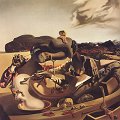 Get
Get  a high-quality picture of
Autumn Cannibalism for your computer or notebook. ‣
As with many artists, Dali was to depict war and conflict in
several of his major works. Autumn Cannibalism was painted in
1936, the year the civil war began in Spain. The painting is an
evocative interpretation of the horror and destruction of war, and
also comments on the devoring nature of sexual relationships.
a high-quality picture of
Autumn Cannibalism for your computer or notebook. ‣
As with many artists, Dali was to depict war and conflict in
several of his major works. Autumn Cannibalism was painted in
1936, the year the civil war began in Spain. The painting is an
evocative interpretation of the horror and destruction of war, and
also comments on the devoring nature of sexual relationships.
On a chest of drawers placed on a Catalonian beach sit the top halves of two people. They are so entangled that the viewer has to look carefully to see which arm belongs to which figure. One figure holds a fork pointed to the other one's head, while it dips a spoon into the malleable flesh. A languid hand holds a gleaming knife that has sliced into the soft flesh of the other. Their featureless heads merge into each other, their individuality becoming indistinguishable.
Pieces of meat are draped about the painting, symbolizing death. The meat also alludes to the temporary nature of life and to the bestial nature of human beings. On one head is an apple, which to Dali represented a struggle between father and son, (the son being the apple, the father William Tell), and beneath the figures is a peeled apple, symbolizing the destruction of the son.
Sun Table (1936)
 Get
Get  a high-quality picture of
Sun Table for your computer or notebook. ‣
Salvador Dali's greatest intellectual and artistic honesty is
probably never to have practiced any sophisticated, gymnastic
aesthetics, in order to place the most disparate and most bizarre
objects in his pictures. Sun Table is a good example of this.
When he painted this composition, Dali did not know why he put a
camel in with all the other elements which belonged to Cadaques. Today
he explains the premonitional character of this image by pointing out
the package of Camel cigarettes placed at the feet of the silhouette
of the young boy, probably himself, and he told me in 1970 that he
had read an article by Martin Gardner which appeared in the magazine
Scientific American under the heading "scientific games," in
which the author explained that "the image on the cover of a package
of cigarettes was full of extraordinary objective hazards - for
example, the English word 'choice' written vertically in capital
letters on the side of the package, when looked at in a mirror,
remains unchanged and perfectly legible." In order to stress the
out-of-context and obsessive character of a camel with all the
magical aspects associated with the animal, Dali wrote later in his
book Dix recettes d'immortalite that "seen through an
electronic microscope it is possible to demonstrate that a camel is
much less precise than a cloud." The table in the middle of the
picture is a table from the cafe Le Casino in Cadaques, on which are
placed one duro and three glasses, the same glasses in which today is
still served tallat, the Catalonian coffee with cream. The
tiled floor is what was being put in Dali's kitchen at the time that
he was painting this picture, having installed himself at a
glass-topped table in the dining room of the house in Port Lligat.
a high-quality picture of
Sun Table for your computer or notebook. ‣
Salvador Dali's greatest intellectual and artistic honesty is
probably never to have practiced any sophisticated, gymnastic
aesthetics, in order to place the most disparate and most bizarre
objects in his pictures. Sun Table is a good example of this.
When he painted this composition, Dali did not know why he put a
camel in with all the other elements which belonged to Cadaques. Today
he explains the premonitional character of this image by pointing out
the package of Camel cigarettes placed at the feet of the silhouette
of the young boy, probably himself, and he told me in 1970 that he
had read an article by Martin Gardner which appeared in the magazine
Scientific American under the heading "scientific games," in
which the author explained that "the image on the cover of a package
of cigarettes was full of extraordinary objective hazards - for
example, the English word 'choice' written vertically in capital
letters on the side of the package, when looked at in a mirror,
remains unchanged and perfectly legible." In order to stress the
out-of-context and obsessive character of a camel with all the
magical aspects associated with the animal, Dali wrote later in his
book Dix recettes d'immortalite that "seen through an
electronic microscope it is possible to demonstrate that a camel is
much less precise than a cloud." The table in the middle of the
picture is a table from the cafe Le Casino in Cadaques, on which are
placed one duro and three glasses, the same glasses in which today is
still served tallat, the Catalonian coffee with cream. The
tiled floor is what was being put in Dali's kitchen at the time that
he was painting this picture, having installed himself at a
glass-topped table in the dining room of the house in Port Lligat.
The Burning Giraffe (1937)
 Get
Get  a high-quality picture of
The Burning Giraffe for your computer or notebook. ‣
Dali believed that both The Burning Giraffe and The
Invention of Monsters were premonitions of war. Both of these
paintings contain the image of a giraffe with its back ablaze, an
image which Dali interpreted as "the masculine cosmic apocalyptic
monster". He first used this image of the giraffe in flames in his
film L'Age d'Or (The Golden Age) in 1930.
a high-quality picture of
The Burning Giraffe for your computer or notebook. ‣
Dali believed that both The Burning Giraffe and The
Invention of Monsters were premonitions of war. Both of these
paintings contain the image of a giraffe with its back ablaze, an
image which Dali interpreted as "the masculine cosmic apocalyptic
monster". He first used this image of the giraffe in flames in his
film L'Age d'Or (The Golden Age) in 1930.
The Burning Giraffe appears as very much a dreamscape, not simply because of the subject but also because of the supernatural aquamarine color of the background. Against this vivid blue color, the flames on the giraffe stand out to great effect.
In the foreground, a woman stands with her arms outstretched. Her forearms and face are blood red, having been stripped to show the muscle beneath the flesh. The woman's face is featureless now, indicating a nightmarish helplessness and a loss of individuality. Behind her, a second woman holds aloft a strip of meat, representing death, entrophy, and the human races capacity to devour and destroy. The women both have elongated phallic shapes growing out from their backs, and these are propped up with crutches - Dali repeatedly uses this symbolism for a weak and flawed society.
The Invention of the Monsters (1937)
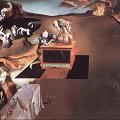 Get
Get  a high-quality picture of
The Invention of the Monsters for your computer or notebook. ‣
The Invention of the Monsters is part of a series of works
that one might term as tumultuous, painted by Dali between 1935 and
1940; the most important among them are Impressions of Africa;
Soft Construction with Boiled Beans: Premonition of Civil War; and
Autumn Cannibalism. These three paintings reflect the troubled
times before World War II. In the book Dali de Gala, the
painter has written about the Premonition of Civil War and
Autumn Cannibalism: "These Iberian people devouring each other
in autumn express the pathos of civil war thought of a phenomenon of
natural history." In The Invention of the Monsters, Dali has
painted his premonition of World War II. Dali began the picture in
1937, in Paris, in his studio on rue de la Tombe-Issoire and resumed
work on it at the winter-sports resort of Semmering, south of Vienna.
When Dali learned that the Art Institute of Chicago had acquired this
work, he sent a telegram with the following explanation: "Am happy
and honored by your acquisition. According to Nostradamus, the
apparition of monsters is a presage of war. This canvas was painted
in the mountains of Semmering a few months before the Anschluss and it
has a prophetic character. The women-horses represent the maternal
river-monsters, the flaming giraffe the male cosmic apocalyptic
monster. The angel-cat is the divine heterosexual monster, the
hour-glass the metaphysical monster. Gala and Dali together the
sentimental monster. The little lonely blue dog is not a true
monster." The theme of the women-horses that one sees here in a herd
bathing in a pond is the same as in Invisible Sleeping Woman,
Horse, Lion. Here the shapes have changed completely: three years
later they will give birth to a series of pictures entitled The
Marsupial Centaurs. About the double figure seen in the
foreground, holding a butterfly and an hourglass in his hands, the
painter has stated precisely that it was the Pre-Raphaelite result of
the double portrait of Dali and Gala painted right behind it.
a high-quality picture of
The Invention of the Monsters for your computer or notebook. ‣
The Invention of the Monsters is part of a series of works
that one might term as tumultuous, painted by Dali between 1935 and
1940; the most important among them are Impressions of Africa;
Soft Construction with Boiled Beans: Premonition of Civil War; and
Autumn Cannibalism. These three paintings reflect the troubled
times before World War II. In the book Dali de Gala, the
painter has written about the Premonition of Civil War and
Autumn Cannibalism: "These Iberian people devouring each other
in autumn express the pathos of civil war thought of a phenomenon of
natural history." In The Invention of the Monsters, Dali has
painted his premonition of World War II. Dali began the picture in
1937, in Paris, in his studio on rue de la Tombe-Issoire and resumed
work on it at the winter-sports resort of Semmering, south of Vienna.
When Dali learned that the Art Institute of Chicago had acquired this
work, he sent a telegram with the following explanation: "Am happy
and honored by your acquisition. According to Nostradamus, the
apparition of monsters is a presage of war. This canvas was painted
in the mountains of Semmering a few months before the Anschluss and it
has a prophetic character. The women-horses represent the maternal
river-monsters, the flaming giraffe the male cosmic apocalyptic
monster. The angel-cat is the divine heterosexual monster, the
hour-glass the metaphysical monster. Gala and Dali together the
sentimental monster. The little lonely blue dog is not a true
monster." The theme of the women-horses that one sees here in a herd
bathing in a pond is the same as in Invisible Sleeping Woman,
Horse, Lion. Here the shapes have changed completely: three years
later they will give birth to a series of pictures entitled The
Marsupial Centaurs. About the double figure seen in the
foreground, holding a butterfly and an hourglass in his hands, the
painter has stated precisely that it was the Pre-Raphaelite result of
the double portrait of Dali and Gala painted right behind it.
Metamorphosis of Narcissus (1937)
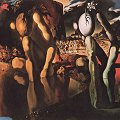 Get
Get  a high-quality picture of
Metamorphosis of Narcissus for your computer or notebook. ‣
Dali's inspiration for this painting came from a conversation
overheard between two fishermen discussing a local man who would
stare at himself in a mirror for hours. One of the men described the
man as having a "bulb in his head"; a colloquium meaning that he was
mentally ill. Dali combined this image with the ancient Greek myth of
Narcissus, who fell in love with his own reflection and was
transformed into the flower that bears his name after his death.
a high-quality picture of
Metamorphosis of Narcissus for your computer or notebook. ‣
Dali's inspiration for this painting came from a conversation
overheard between two fishermen discussing a local man who would
stare at himself in a mirror for hours. One of the men described the
man as having a "bulb in his head"; a colloquium meaning that he was
mentally ill. Dali combined this image with the ancient Greek myth of
Narcissus, who fell in love with his own reflection and was
transformed into the flower that bears his name after his death.
The hand on the right that holds an egg, out of which a narcissus flower grows, echoes the configuration of Narcissus and his reflection in the lake. The same configuration occurs again at the top of the mountains that are directly above the figure of Narcissus, who stands on a dais admiring his body. The familiar sight of ants and a scavenging dog both appear around the hand, symbolizing the death and decay that has taken place.
The Metamorphosis of Narcissus was painted using oil on canvas, while Dali and Gala were traveling in Italy. The influence of the great Italian masters on Dali can be seen in the Classical mythic theme to his use of color and form.
Sleep (1937)
 Get
Get  a high-quality picture of
Sleep for your computer or notebook. ‣
Sleep was painted for Edward James, a British millionaire
who was Dali's patron from 1936 to 1939. Sleep deals with a
subject that fascinated the Surrealists: the world of dreams. They
believed that the freedom of the subconscious within sleep could be
tapped into and then used creatively.
a high-quality picture of
Sleep for your computer or notebook. ‣
Sleep was painted for Edward James, a British millionaire
who was Dali's patron from 1936 to 1939. Sleep deals with a
subject that fascinated the Surrealists: the world of dreams. They
believed that the freedom of the subconscious within sleep could be
tapped into and then used creatively.
Sleep is a visual rendering of the body's collapse into sleep, as if into a separate state of being. Against a deep blue summer sky, a huge disembodied head with eyes dissolved in sleep, hangs suspended over an almost empty landscape. The head is "soft", appearing both vulnerable and distorted; what should be a neck tapers away to drop limply over a crutch. A dog appears, its head in a crutch, as if half asleep itself.
The head is propped above the land by a series of wooden crutches. The mouth, nose and also the eyes are all held in place by the crutches, suggesting that the head might disintegrate if they were removed. Crutches were a familiar sight in Dali's work. In The Secret Life of Salvador Dali, the artist wrote that he had imagined sleep as a heavy monster that was "held up by the crutches of reality".
Swans Reflecting Elephants (1937)
 Get
Get  a high-quality picture of
Swans Reflecting Elephants for your computer or notebook. ‣
Swans Reflecting Elephants contains one of Dali's famous
double images. The double images were a major part of Dali's
"paranoia-critical method", which he put forward in his 1935 essay
"The Conquest of the Irrational". He explained his process as a
"spontaneous method of irrational understanding based upon the
interpretative critical association of delirious phenomena". Dali used
this method to bring forth the hallucinatory forms, double images and
visual illusions that filled his paintings during the Thirties.
a high-quality picture of
Swans Reflecting Elephants for your computer or notebook. ‣
Swans Reflecting Elephants contains one of Dali's famous
double images. The double images were a major part of Dali's
"paranoia-critical method", which he put forward in his 1935 essay
"The Conquest of the Irrational". He explained his process as a
"spontaneous method of irrational understanding based upon the
interpretative critical association of delirious phenomena". Dali used
this method to bring forth the hallucinatory forms, double images and
visual illusions that filled his paintings during the Thirties.
As with the earlier Metamorphosis of Narcissus, Swans Reflecting Elephants uses the reflection in a lake to create the double image seen in the painting. In The Metamorphosis of Narcissus the reflection of Narcissus is used to mirror the shape of the hand on the right of the picture. Here, the three swans in front of bleak, leafless trees are reflected in the lake so that the swans' heads become the elephants' heads and the trees become the bodies of the elephants.
In the background of the painting is a Catalonian landscape depicted in fiery fall colors, the brushwork creating swirls in the cliffs that surround the lake, to contrast with the cool stillness of the water.
The Endless Enigma (1938)
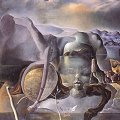 Get
Get  a high-quality picture of
The Endless Enigma for your computer or notebook. ‣
This composition is probably the best example of
paranoiac-critical activity in operation in the paintings done by
Dali. He is not satisfied with pursuing a double image but succeeds in
accumulating and making rise simultaneously, or one after another
according to the particular capacity of the viewer, six different
subjects, thus justifying the title The Endless Enigma which
he gave to this picture.
a high-quality picture of
The Endless Enigma for your computer or notebook. ‣
This composition is probably the best example of
paranoiac-critical activity in operation in the paintings done by
Dali. He is not satisfied with pursuing a double image but succeeds in
accumulating and making rise simultaneously, or one after another
according to the particular capacity of the viewer, six different
subjects, thus justifying the title The Endless Enigma which
he gave to this picture.
The subjects are in succession: a reclining philosopher; a greyhound lying down; a mythological beast; the face of the great Cyclopean, Cretin; a mandolin; a compotier of fruits and figs on a table; and finally a woman seen from the back mending a sail. One can perceive here, besides, appearing in the corner at the right, the upper part of Gala's face with a turban on her head and at the bottom left, balanced on a stick, the skeletal remains of a grilled sardine. Several times during the same period Dali depicted grilled sardines, placed in dishes, together with telephones, such as : Beach with Telephone, The Sublime Moment, Imperial Violets, or The Enigma of Hitler, in all of which this instrument symbolizes the period of great political tension in Europe which preceded World War II, particularly at the time of Munich, when the telephone played such an important role in the negotiations between the Allies and Hitler. Most of these pictures, including The Endless Enigma, were started - indeed, almost all were painted - at the estate of Coco Chanel, "La Paula," at Roquebrune on the Cote d'Azur.
Impressions of Africa (1938)
 Get
Get  a high-quality picture of
Impressions of Africa for your computer or notebook. ‣
Impressions of Africa is a misleading title as Dali never
visited the continent; the title is taken from a play by Raymond
Roussel, who was greatly admired for his double meanings - the
literal equivalent of Dali's double visual images. In the background,
there are groups of figures clustered together; several are double
images or visual illusions. Gala's face is the most dominant image;
she appears ghostly, her eyes formed by the dark arches of the
building behind her.
a high-quality picture of
Impressions of Africa for your computer or notebook. ‣
Impressions of Africa is a misleading title as Dali never
visited the continent; the title is taken from a play by Raymond
Roussel, who was greatly admired for his double meanings - the
literal equivalent of Dali's double visual images. In the background,
there are groups of figures clustered together; several are double
images or visual illusions. Gala's face is the most dominant image;
she appears ghostly, her eyes formed by the dark arches of the
building behind her.
In the foreground of the painting is Dali, one hand reaching out toward the viewer; he has used a foreshortening technique here so that his arm appears almost in 3D. He was greatly interested in techniques that enabled him to create a feeling of space, distance, and depth. During 1938, Dali was traveling in Italy, ostensibly to study the great Italian artists' techniques. His face is only partially visible and it is in shadow so that the one staring eye that we can see appears more distinct. Dali wanted to give an impression of extreme concentration, to convey the idea that he is trying to "see like a medium"; to capture subliminal images to be recorded on his easel.
Spain (1938)
 Get
Get  a high-quality picture of
Spain for your computer or notebook. ‣
The figure of the woman leaning her elbow on a night stand
symbolizes the Spanish Civil War. Dali wrote in his Secret
Life: "Throughout all martyrized Spain rose an odor of incense,
of the burning flesh of priests, of spiritual quartered flesh, mixed
with the powerful scent of the sweat of mobs fornicating among
themselves and with Death." The torso and the face of the female
figure are made up of groups of Renaissance warriors, of
condottieri, inspired by a combat of horsemen done by Leonardo
da Vinci. Although signed in 1938, this picture was probably started
sooner. The other very remarkable works of this series are The
Great Paranoiac, Paranoia, Perspectives, and Head of a Woman
Having the Form of a Battle. Dali exhibited nearly all these
paintings together in a one-man show that he, aided by Gala,
organized in February 1939 in the studio where the couple was living
on the rue de la Tombe-Issoire in Paris. Friends and society people
came to see this exhibition of paranoiac-critical activity, and Dali
remembers that the first to arrive and the last to leave was Picasso,
who asked especially to see Spain.
a high-quality picture of
Spain for your computer or notebook. ‣
The figure of the woman leaning her elbow on a night stand
symbolizes the Spanish Civil War. Dali wrote in his Secret
Life: "Throughout all martyrized Spain rose an odor of incense,
of the burning flesh of priests, of spiritual quartered flesh, mixed
with the powerful scent of the sweat of mobs fornicating among
themselves and with Death." The torso and the face of the female
figure are made up of groups of Renaissance warriors, of
condottieri, inspired by a combat of horsemen done by Leonardo
da Vinci. Although signed in 1938, this picture was probably started
sooner. The other very remarkable works of this series are The
Great Paranoiac, Paranoia, Perspectives, and Head of a Woman
Having the Form of a Battle. Dali exhibited nearly all these
paintings together in a one-man show that he, aided by Gala,
organized in February 1939 in the studio where the couple was living
on the rue de la Tombe-Issoire in Paris. Friends and society people
came to see this exhibition of paranoiac-critical activity, and Dali
remembers that the first to arrive and the last to leave was Picasso,
who asked especially to see Spain.
The Enigma of Hitler (1939)
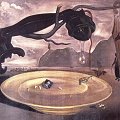 Get
Get  a high-quality picture of
The Enigma of Hitler for your computer or notebook. ‣
The Enigma of Hitler contributed to Dali's expulsion from
the Surrealist movement. Since the early Thirties Hitler had
fascinated Dali, mainly because of the shape of his back. In 1934, he
had to be stopped from painting a swastika armband on the figure of a
wet nurse (the nurse is seen in this painting at the edge of the
sea). The Surrealists saw Dali's obsession with Hitler as evidence of
his dubious moral and political beliefs, however, Dali had long
stated that he was apolitical, viewing wars and dictators alike as
inevitable parts of human nature. Dali explained The Enigma of
Hitler was an interpretation of several dreams he had about
Hitler - one had shown Neville Chamberlain's umbrella turning into a
bat - a symbol from his childhood that filled him with fear.
a high-quality picture of
The Enigma of Hitler for your computer or notebook. ‣
The Enigma of Hitler contributed to Dali's expulsion from
the Surrealist movement. Since the early Thirties Hitler had
fascinated Dali, mainly because of the shape of his back. In 1934, he
had to be stopped from painting a swastika armband on the figure of a
wet nurse (the nurse is seen in this painting at the edge of the
sea). The Surrealists saw Dali's obsession with Hitler as evidence of
his dubious moral and political beliefs, however, Dali had long
stated that he was apolitical, viewing wars and dictators alike as
inevitable parts of human nature. Dali explained The Enigma of
Hitler was an interpretation of several dreams he had about
Hitler - one had shown Neville Chamberlain's umbrella turning into a
bat - a symbol from his childhood that filled him with fear.
The telephone was an image Dali used often, such as in the 1938 painting, The Mountain Lake. In The Enigma of Hitler the mouthpiece has mutated into threatening lobster claws, symbolic of the danger of these times with the onset of war. The phone hangs from a mutilated olive branch, signifying the death of hope.
Philosopher Illuminated by the Light of the Moon and the Setting Sun (1939)
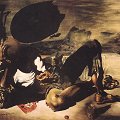 Get
Get  a high-quality picture of
Philosopher Illuminated by the Light of the Moon and the Setting Sun for your computer or notebook. ‣
This large painting was begun shortly after Dali and Gala had left
Mlle Chanel's residence on the Cote d'Azur. They were then settled in
the hotel at Font-Romeu in the Pyrenees. Dali has told me (Robert
Descharnes) that, one evening, when he was taking a walk along the
coast road, he caught sight of a silhouette which exactly resembled
that of General Gamelin, commander in chief of the French armies. A
few days later, the hotel closed its doors and was broke out. After a
few weeks spent in Paris, Dali and Gala left to live in Arcachon. The
painter has stressed the fact that the light and colors in the
landscapes of this period are due in large part to this region along
the Atlantic where the couple spent a few months before the German
invasion. By contrast, the figure in this painting is the result as
much of Dali's being fed up with the Surrealists as of his regrets as
not being able to return to Port Lligat because of the Civil War,
which was not yet over.
a high-quality picture of
Philosopher Illuminated by the Light of the Moon and the Setting Sun for your computer or notebook. ‣
This large painting was begun shortly after Dali and Gala had left
Mlle Chanel's residence on the Cote d'Azur. They were then settled in
the hotel at Font-Romeu in the Pyrenees. Dali has told me (Robert
Descharnes) that, one evening, when he was taking a walk along the
coast road, he caught sight of a silhouette which exactly resembled
that of General Gamelin, commander in chief of the French armies. A
few days later, the hotel closed its doors and was broke out. After a
few weeks spent in Paris, Dali and Gala left to live in Arcachon. The
painter has stressed the fact that the light and colors in the
landscapes of this period are due in large part to this region along
the Atlantic where the couple spent a few months before the German
invasion. By contrast, the figure in this painting is the result as
much of Dali's being fed up with the Surrealists as of his regrets as
not being able to return to Port Lligat because of the Civil War,
which was not yet over.
The reclining man is inspired by all the fishermen of Port Lligat, particularly by one named Ramon de Hermosa, whose motto was: "There are years when you don't feel like doing anything at all"; he had been in this state since childhood, and his immeasurable laziness had earned him much prestige among the fishermen of Cadaques. Dali related that Gala had asked Ramon to pump water each evening at the well near the house to fill the washtub; she noticed at the end of the second day that there was not a drop of water in the tub, although she could hear the rhythmic noise of the pump. Dali and Gala then discovered Ramon stretched out at the foot of an olive tree in the act of cleverly imitating the grinding sound of the pump by striking two pieces of iron against each other, having taken beforehand the precaution of making the sound of his instrument perfect by suspending the two pieces of metal from two strings tied on the branches so as to expend the least effort. All the ancestral Mediterranean wisdom contained in the figures painted in this canvas shows that at bottom Dali was never profoundly influenced or completely assimilated by the Parisian Surrealist group.
By placing this painting in juxtaposition with a passage from The Secret Life one may better understand its meaning. "After the tense, agitated conversations in Paris, swarming with double meanings, maliciousness, and diplomacy, the stories of Ramon achieved a serenity of soul and a height of boring anecdotism which was incomparable.
"The accounts of the fishermen of Port Lligat were the same, perfectly Homeric, and of a substantial reality for my brain weary of 'wit' and of affected manners. Gala and I spent entire months without any other company than that of Lydia, her two sons, the maid, Ramon de Hermosa, and about ten fishermen who kept their boats at Port Lligat."
Daddy Longlegs of the Evening... Hope! (1940)
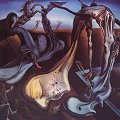 Get
Get  a high-quality picture of
Daddy Longlegs of the Evening... Hope! for your computer or notebook. ‣
Another work which stands on the edge between Dali's periods of
Surrealism and Classicism. This painting is also very important for
several other reasons, namely that it was the very first work to be
purchased by Mr. and Mrs. A. Reynolds Morse, the renowned collectors
of Dali's art who founded the Salvador Dali Museum, in St.
Petersburg, Florida. When the Morses saw the painting at auction,
they decided to purchase it, and felt that they had gotten quite a
bargain. However, when they went to purchase the painting, they
found that Dali refused to sell the work without the original frame
along with it. Apparently, Mr. Morse had only purchased the work
itself, and actually had to pay more for the frame than for the
painting! This anecdote is a good example of the way Dali had
matured, with Gala's help, into a shrewd businessman who was keenly
aware of his value.
a high-quality picture of
Daddy Longlegs of the Evening... Hope! for your computer or notebook. ‣
Another work which stands on the edge between Dali's periods of
Surrealism and Classicism. This painting is also very important for
several other reasons, namely that it was the very first work to be
purchased by Mr. and Mrs. A. Reynolds Morse, the renowned collectors
of Dali's art who founded the Salvador Dali Museum, in St.
Petersburg, Florida. When the Morses saw the painting at auction,
they decided to purchase it, and felt that they had gotten quite a
bargain. However, when they went to purchase the painting, they
found that Dali refused to sell the work without the original frame
along with it. Apparently, Mr. Morse had only purchased the work
itself, and actually had to pay more for the frame than for the
painting! This anecdote is a good example of the way Dali had
matured, with Gala's help, into a shrewd businessman who was keenly
aware of his value.
However, rather than being sour about the experience, which would have been understandable, the Morses instead started buying more and more works, and eventually became lifelong traveling companions and friends of the Dali's. It was their efforts that gathered together nearly 100 oil paintings, hundreds of watercolors and drawings, and a vast archival library that now comprise the museum in St. Petersburg, Florida.
Each of the objects in the work itself is done in stunning detail. The scene is set upon an apocalyptic plain, and one immediately seems to get a feeling of dread or misgiving. Because Dali intended this work to be an examination of the horrors of World War II that had now begun in earnest, Dali fills the scene with allegorical references to that event.
In the upper left hand corner of the painting stands a cannon, propped up by a crutch which here symbolizes death and war. Out of the mouth of the cannon spill two distinct objects, the lower being a 'soft' or somewhat fluid biplane, and the other a white horse, galloping at a mad pace, its muscles and facial contortions suggesting power, speed and control.
The horse may symbolize one of the Four Horsemen of the Apocalypse, and the events of 1940 in Europe could have certainly appeared Apocalyptical, especially to one as sensitive as Dali. The soft airplane, and another nearby object, the winged victory figure, are symbolic of "victory born of a broken wing" as Dali described it. Salvador felt that the use of air power would be the decisive element of the war, the very key to victory itself. History has shown that this is at least partially true.
Nearer the center of the painting is another soft figure, what Dali calls a 'soft self-portrait', an image from other works long since past. Its decaying body is drooped over a dead tree, it has two inkwells propped on it, and it's holding a violin. The ink wells are symbolic of the signing of treaties, although Dali also occasionally used them to express sexuality as well. There are ants quickly devouring the soft head, and though we have not seen very many Dalinian ants to this point, they are another common symbol for Dali. In general they represent decay and decomposition, as it is they (and many other insects as Dali might point out) who eventually devour everything in the ground, and return it to its chemical components. For this reason Dali often included ants as symbols of death, decay, and purification, all of which he was obsessed with.
In the lower left hand corner, a cupid figure looks on the scene, holding its face in one hand, and reaching out the other towards the destruction he sees before him. This agonized cupid almost seems to verbalize its horror in overlooking the terrible scene being played out before it. Remember that Dada, and eventually Surrealism were born out of the rebellion against the mindless destruction of World War I. In reality, none of the issues that caused that war were ever rectified, and this led to World War II, which shocked and outraged Dali and many others, prompting these sorts of works that seem to say "Dear God not again!"
However, in the midst of such pain and terror, there is always hope, and this is symbolized by the daddy longlegs spider resting in almost the exact center of the painting, near the ants on the soft self portrait. The daddy longlegs, when seen in the evening, is a French symbol for hope. Thus, Dali is offering us solace, even in the middle of such terrible devastation. This dualistic nature of his is slowly starting to shift more and more towards the positive, and towards themes and subjects that are more in the conscious realm of things. This predates his entering his Classical period in 1941, but shows the same tendencies nonetheless.
Old Age, Adolescence, Infancy (The Three Ages) (1940)
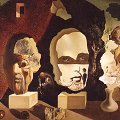 Get
Get  a high-quality picture of
Old Age, Adolescence, Infancy (The Three Ages) for your computer or notebook. ‣
The work "Old Age, Adolescence, Infancy (The Three Ages)" was
completed in 1940, near the time when Dali and Gala fled from France
in anticipation of the coming Nazi invasion. It was during this time
that Dali was being primed by Gala to move away from his surrealistic
roots and towards more common and traditional themes. Although this
painting is officially considered a Surreal work, it is an excellent
example of the transformation that the artist was undergoing at the
time. The painting currently hangs in the Salvador Dali Museum in
St. Petersburg, and is a valuable member of that collection.
a high-quality picture of
Old Age, Adolescence, Infancy (The Three Ages) for your computer or notebook. ‣
The work "Old Age, Adolescence, Infancy (The Three Ages)" was
completed in 1940, near the time when Dali and Gala fled from France
in anticipation of the coming Nazi invasion. It was during this time
that Dali was being primed by Gala to move away from his surrealistic
roots and towards more common and traditional themes. Although this
painting is officially considered a Surreal work, it is an excellent
example of the transformation that the artist was undergoing at the
time. The painting currently hangs in the Salvador Dali Museum in
St. Petersburg, and is a valuable member of that collection.
The work utilizes Dali's now mature double imagery techniques to transform elements from the Catalan coastline into three separate and distinct faces that represent the three so called 'ages' of man. To the far right, a brick wall extends towards the center of the painting, and in what would appear to be a hole, a small cliff with trees emerges. On the face of the cliff is superimposed the image of a bowed, cloaked figure, whose head and clothing blend together with the cliff itself to create the double image of an elderly, mustached gentleman.
The center face, that of the adolescent, if formed from the combination of the towering cliffs in the background and the figures of both Lucia (Dali's nursemaid) and Dali himself, both with their backs to us. The cliffs both have an eye superimposed on them, and Lucia's clothing is creased in such a way that these elements combine to form the face of a young man, perhaps in his twenties.
To the far right, the final face, that of the infant, is also formed from the combination of both scenery and a figure in the scenery. The cliffs to the far right form the edge of the face, while the figure of the netmender, sitting with her back towards us, helps to form up the nose, mouth and teeth of the smiling infant. The net itself looks like some sort of bib or collar. A second netmender figure is seen further to the right, and farther down the beach.
All together, these faces create an ambitious double image painting that makes extensive use of elements from Dali's past that were important to him. In many ways, he himself may have been trying to directly express how these elements had a profound effect on him, and were central to his being. Most important among these are the direct references to the Catalan coastline, which was the subject of many Dalinian paintings throughout his career. Also important is the presence of Lucia, who nursed Dali back to health as a child, and to whom he had a deep sentimental attachment.
In general, the author feels that Dali's use of these three allegorical faces is in itself a double meaning. On the surface, he may be discussing the inevitable effects of time on the human individual, but it is his choice of using the double imagery technique that is particularly telling. As World War II increased in intensity, Dali must have certainly been disgusted with the bureaucracies and governments that had caused the conflict. As a Surrealist, Dali had long ago turned away from such institutions, and is herein commenting on the double talk, double meaning, and inherent shortcomings of such a system.
Slave Market with the Disappearing Bust of Voltaire (1940)
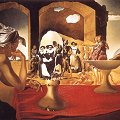 Get
Get  a high-quality picture of
Slave Market with the Disappearing Bust of Voltaire for your computer or notebook. ‣
The concept of a still life placed in front of an architectural
structure through which one glimpses a fragment of the landscape is
one that Dali has made use of frequently to show to advantage the
bust of Voltaire by the sculptor Houdon, which disappears to give
place to a group of people. This work was done in the United States at
Arcachon in 1940, in which we find again the compotier of The
Endless Enigma and Gala, who "by her patient love protected me
from the ironic world crawling with slaves." Dali means by this that
he attributes to Gala's gaze the magic power of annihilating the
image of Voltaire in order to protect him from any vestige of the
skeptical French philosophy of the eighteen century and its
consequences. Scientific American magazine in the December
1971 issue used a detail from the Slave Market with Disappearing
Bust of Voltaire to demonstrate the physical structure of the
perception system of sight in which the optical neurons reverse the
images. While painting this picture, Dali related in Dali de
Gala: "I kept reciting without ever stopping the poem of Joan
Salvat Papasseit, 'Love and War, the Salt of the Earth.'" Salvat
Papasseit was a Catalonian anarchist whom Dali greatly admired. In
Barcelona he was accused of having become an extreme rightist because
the only thing he did was to apologize for the war at a time when
everybody else had become pacifists.
a high-quality picture of
Slave Market with the Disappearing Bust of Voltaire for your computer or notebook. ‣
The concept of a still life placed in front of an architectural
structure through which one glimpses a fragment of the landscape is
one that Dali has made use of frequently to show to advantage the
bust of Voltaire by the sculptor Houdon, which disappears to give
place to a group of people. This work was done in the United States at
Arcachon in 1940, in which we find again the compotier of The
Endless Enigma and Gala, who "by her patient love protected me
from the ironic world crawling with slaves." Dali means by this that
he attributes to Gala's gaze the magic power of annihilating the
image of Voltaire in order to protect him from any vestige of the
skeptical French philosophy of the eighteen century and its
consequences. Scientific American magazine in the December
1971 issue used a detail from the Slave Market with Disappearing
Bust of Voltaire to demonstrate the physical structure of the
perception system of sight in which the optical neurons reverse the
images. While painting this picture, Dali related in Dali de
Gala: "I kept reciting without ever stopping the poem of Joan
Salvat Papasseit, 'Love and War, the Salt of the Earth.'" Salvat
Papasseit was a Catalonian anarchist whom Dali greatly admired. In
Barcelona he was accused of having become an extreme rightist because
the only thing he did was to apologize for the war at a time when
everybody else had become pacifists.
This work exemplifies the caliber of paintings that Dali was creating during this period. It is a perfect example of an instantaneous paranoiac-critical transformation. Dali had long been experimenting with the idea of double imagery, and this work so perfectly exemplifies it that it was used by the cover of Scientific American in 1971 to illustrate the concept.
This work lets us experience Dali's paranoiac-critical transformations in a unique and personal way. Any change in head position, or time itself, is expressed as a switch between the shifting images of the Dutch traders or the bust of French philosopher Voltaire.
The shirtless slave girl in the foreground is surmised to be Gala herself, overseeing the transaction. The faces, collars, and midriffs of the two Dutch merchants become the eyes, nose, and chin of the bust of Voltaire. Although the brain is unable to focus on both images simultaneously, they are blended together perfectly, and in such a way as to suggest a more subtle level of interaction.
The landscape of Catalonia makes another appearance here, and parts of it are made into a more subtle double image on the left side of the painting. Notice the gently downward sloping hill, nearest the building on the right, and how it also becomes a pear sitting in a fruit dish propped up on the table at which Gala is sitting. This is particularly interesting, since like many other double images, it incorporates parts of both background and foreground. Additionally, a plum sitting to the left of the pear also becomes the buttocks of one of the men who is standing there watching the scene.
Two Pieces of Bread, Expressing the Sentiment of Love (1940)
 Get
Get  a high-quality picture of
Two Pieces of Bread, Expressing the Sentiment of Love for your computer or notebook. ‣
This beautiful still life, depicting three slices of bread, a few
crumbs, and a chess pawn, is a remarkable example of the way in which
Dali succeeds in adding an epic dimension to the most ordinary of
everyday things. This picture was painted in Arcachon in the spring
of 1940. Dali has said about the "intervention, from an anecdotal
point of view," of Marcel Duchamp in this oil: "Gala and I used to
play chess every afternoon, at the same time that I was in the process
of painting the slices of bread. I was trying to make the surface on
which the rough crumbs of bread were placed very smooth. Often there
were things scattered about on the floor for instance, the pawns. One
day, instead of putting them all back in the box, one of them
remained placed in the middle of the model of my still life.
Afterwards we had to find another chess set in order to continue our
games, because I was using this one and would not allow anyone to
remove it."
a high-quality picture of
Two Pieces of Bread, Expressing the Sentiment of Love for your computer or notebook. ‣
This beautiful still life, depicting three slices of bread, a few
crumbs, and a chess pawn, is a remarkable example of the way in which
Dali succeeds in adding an epic dimension to the most ordinary of
everyday things. This picture was painted in Arcachon in the spring
of 1940. Dali has said about the "intervention, from an anecdotal
point of view," of Marcel Duchamp in this oil: "Gala and I used to
play chess every afternoon, at the same time that I was in the process
of painting the slices of bread. I was trying to make the surface on
which the rough crumbs of bread were placed very smooth. Often there
were things scattered about on the floor for instance, the pawns. One
day, instead of putting them all back in the box, one of them
remained placed in the middle of the model of my still life.
Afterwards we had to find another chess set in order to continue our
games, because I was using this one and would not allow anyone to
remove it."
Pictures of bread occupy an important place in Dali's work, not only in painting but also in objects, such as Retrospective Bust of a Woman. He himself has explained the presence of bread in his works when writing about one of his paintings of 1945, Basket of Bread, in the catalogue of an exhibition at the Bignou Gallery in New York: "My aim was to retrieve the lost technique of the painters of the past, to succeed in depicting the immobility of the pre-explosive object. Bread has always been one of the oldest subjects of fetishism and obsession in my work, the first and the one to which I have remained the most faithful. I painted the same subject nineteen years ago, The Basket of Bread. By making a very careful comparison of the two pictures, everyone can study all the history of painting right there, from the linear charm of primitivism to stereoscopic hyper-aestheticism."
Salvador Dali Art

|
|
More
Articles
 Art Encyclopedia A world history of art in articles.
Art Encyclopedia A world history of art in articles.
Modernism
Salvador Dali
Art, life, and world of surreal.
Early years. Art, paintings, and works.
Surreal years. Art, paintings, and works.
Classical years. Art, paintings, and works.
Art
 Art Wallpapers Art image collections for your desktop.
Art Wallpapers Art image collections for your desktop.
Munch Art, $19
(75 pictures)
Malevich Art, $25
(105 pictures)
Modigliani Art, $29
(135 pictures)
Klee Art, $25
(150 pictures)
Miro Art, $35
(150 pictures)
Matisse Art, $29
(180 pictures)
Picasso Art, $29
(175 pictures)
Dali Art, $35
(275 pictures)
Chagall Art, $35
(175 pictures)
